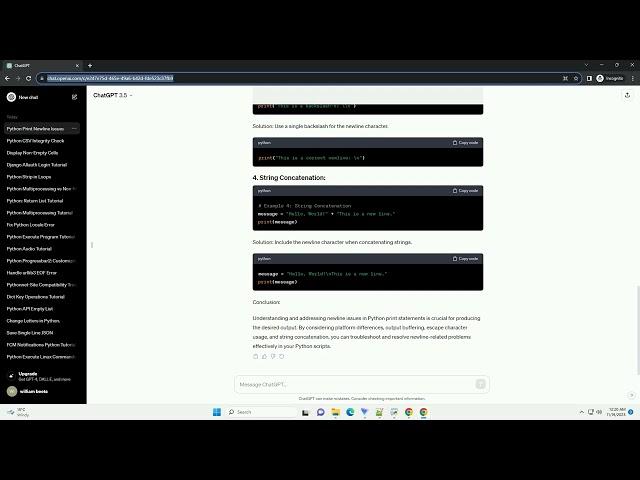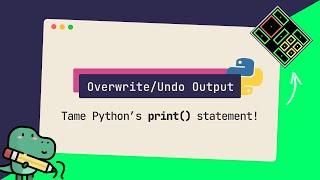
python print newline sometimes does not work Why
Download this code from https://codegive.com
Title: Understanding Python: When print Doesn't Print Newlines
In Python, the print function is a fundamental tool for displaying output to the console. However, you may encounter situations where the newline character (\n) seemingly fails to produce a newline. This tutorial explores common scenarios causing this behavior and provides solutions.
The print function in Python automatically appends a newline character at the end, which separates consecutive lines of output. For example:
Output:
One common pitfall is when you print multiple items on the same line using a comma (,). The newline character won't work as expected in such cases:
Output:
If you concatenate strings without including the newline character, the lines won't be separated:
Output:
When you want to concatenate strings but still have newlines, include the newline character explicitly:
Output:
If you need to print multiple items on separate lines, use multiple print statements:
Output:
The print function has an end parameter that specifies what to print at the end. By default, it's set to '\n', but you can change it:
Output:
Understanding when and why print may not produce newlines is crucial for effective Python coding. By being aware of the scenarios discussed and applying the suggested solutions, you can ensure proper formatting in your output.
Happy coding!
ChatGPT
Title: Troubleshooting Newline Issues in Python Print Statements
Introduction:
When working with Python, the print statement is a fundamental tool for displaying output. However, you might encounter situations where newline characters (\n) don't seem to work as expected. This tutorial will explore common reasons behind newline issues in Python print statements and provide solutions to overcome them.
Possible Causes:
Platform Differences:
Python runs on various platforms, and the way newline characters are interpreted can differ. Windows, for example, uses '\r\n' (carriage return + newline), while Unix-based systems use '\n' for line breaks. This can lead to unexpected behavior when running Python scripts across different platforms.
Output Buffering:
Python's output may be buffered, meaning the print statement doesn't immediately flush the output to the console. This buffering can cause newlines to be delayed or grouped together.
Escape Character Confusion:
Incorrect use of escape characters may lead to unexpected results. For instance, mistakenly using double backslashes (\\n) instead of a single backslash (\n) can prevent the
Title: Understanding Python: When print Doesn't Print Newlines
In Python, the print function is a fundamental tool for displaying output to the console. However, you may encounter situations where the newline character (\n) seemingly fails to produce a newline. This tutorial explores common scenarios causing this behavior and provides solutions.
The print function in Python automatically appends a newline character at the end, which separates consecutive lines of output. For example:
Output:
One common pitfall is when you print multiple items on the same line using a comma (,). The newline character won't work as expected in such cases:
Output:
If you concatenate strings without including the newline character, the lines won't be separated:
Output:
When you want to concatenate strings but still have newlines, include the newline character explicitly:
Output:
If you need to print multiple items on separate lines, use multiple print statements:
Output:
The print function has an end parameter that specifies what to print at the end. By default, it's set to '\n', but you can change it:
Output:
Understanding when and why print may not produce newlines is crucial for effective Python coding. By being aware of the scenarios discussed and applying the suggested solutions, you can ensure proper formatting in your output.
Happy coding!
ChatGPT
Title: Troubleshooting Newline Issues in Python Print Statements
Introduction:
When working with Python, the print statement is a fundamental tool for displaying output. However, you might encounter situations where newline characters (\n) don't seem to work as expected. This tutorial will explore common reasons behind newline issues in Python print statements and provide solutions to overcome them.
Possible Causes:
Platform Differences:
Python runs on various platforms, and the way newline characters are interpreted can differ. Windows, for example, uses '\r\n' (carriage return + newline), while Unix-based systems use '\n' for line breaks. This can lead to unexpected behavior when running Python scripts across different platforms.
Output Buffering:
Python's output may be buffered, meaning the print statement doesn't immediately flush the output to the console. This buffering can cause newlines to be delayed or grouped together.
Escape Character Confusion:
Incorrect use of escape characters may lead to unexpected results. For instance, mistakenly using double backslashes (\\n) instead of a single backslash (\n) can prevent the
Тэги:
#python_does_not_equal #python_does_int_round_down #python_does_string_contain #python_does_none_evaluate_to_false #python_does_file_exist #python_does_return_break_loop #python_does_not_contain #python_does_directory_exist #python_does_not_start_with #python_newline_in_string #python_newline_character #python_newline_join #python_newline_not_working #python_newline_in_f_string #python_newline_atКомментарии:
Lowest Taxes in Europe
Regulated United Europe
Uriah Heep - Dreammare (1970)
Dony40 Vinyl Live Music
CODES | RAW CUTS
RAW CUTS
END TIME PEOPLE #shorts #andrewdev #biblecalls
Bible Calls
Overwrite Previously Printed Lines | Python Snippets #3
Thijmen’s Coding Snippets
Revolutionize your video engagement with Momentus by MultiTV!
MultiTV Solution








![[未刪減完整版|患癌的兒子]劉志爲報恩養父劉建國給了他兩百萬和豪宅,兩個兒子來找劉建國要錢,大兒子以爲父親肝癌晚期不願意用這錢給父親治病,甯願給丈母娘買房給小舅子買車,直到發現其實得肝癌的是自己... [未刪減完整版|患癌的兒子]劉志爲報恩養父劉建國給了他兩百萬和豪宅,兩個兒子來找劉建國要錢,大兒子以爲父親肝癌晚期不願意用這錢給父親治病,甯願給丈母娘買房給小舅子買車,直到發現其實得肝癌的是自己...](https://rtube.cc/img/upload/NEVkS3k0bDVoSlI.jpg)

















